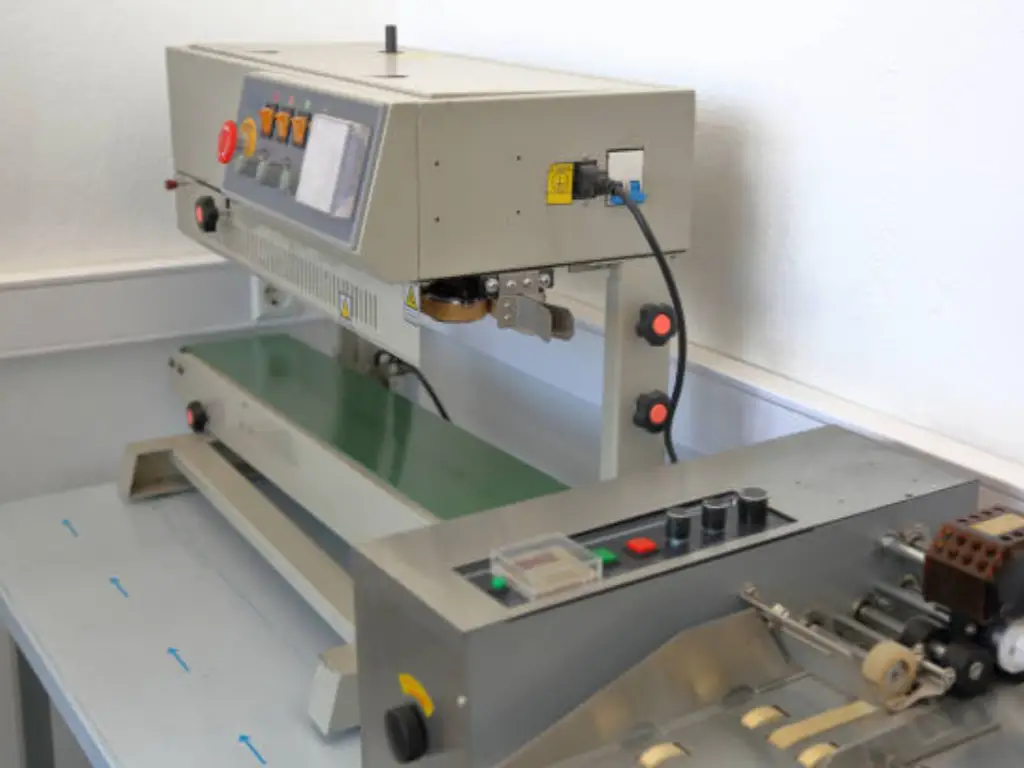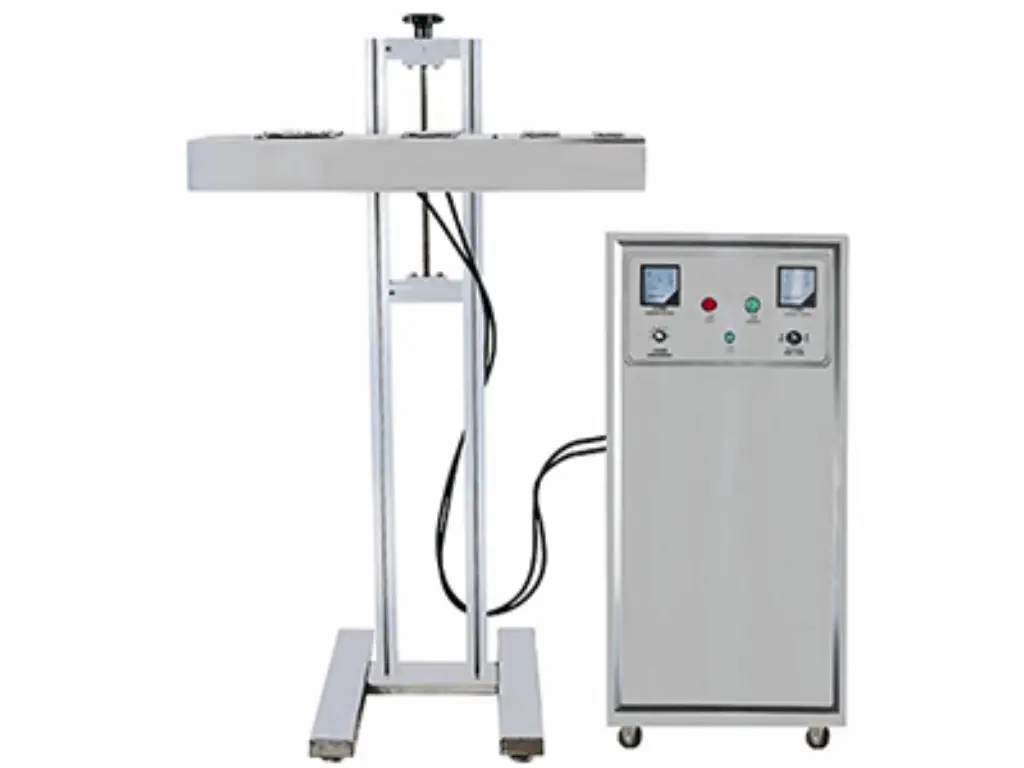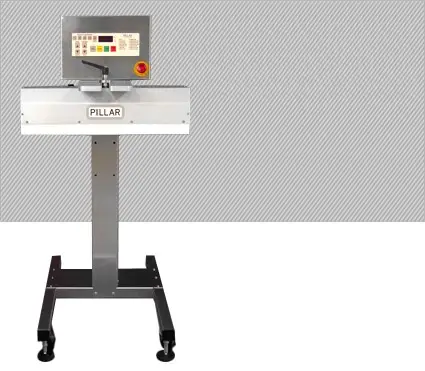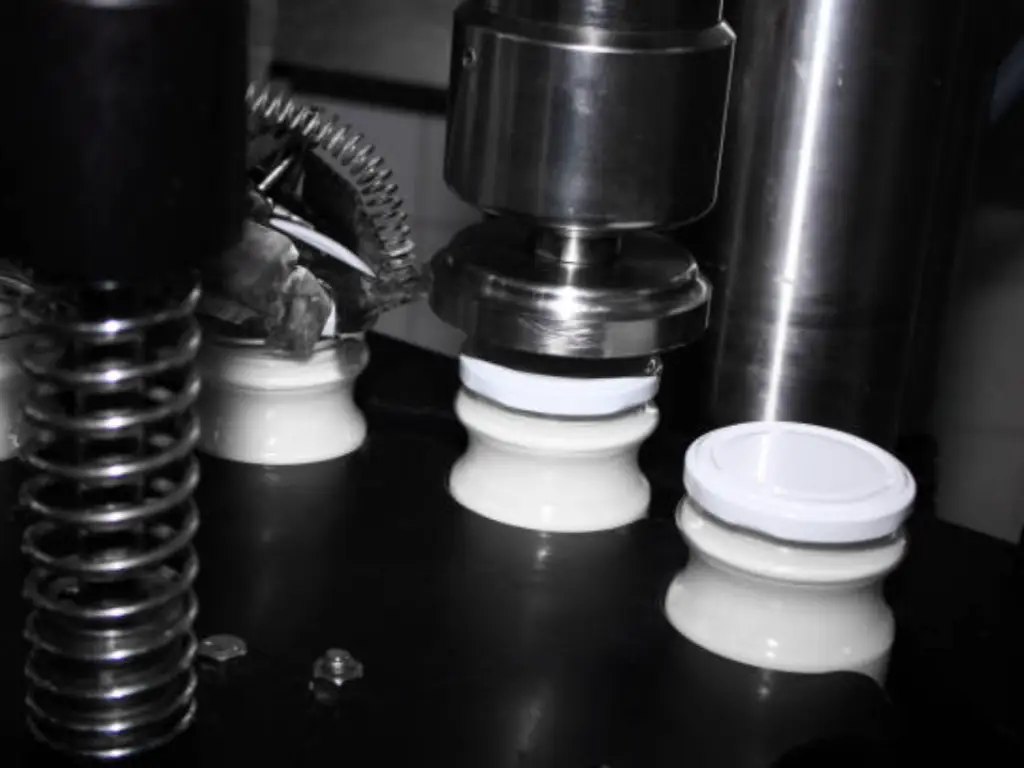In the context of contemporary packaging, product integrity is not just another aspect of quality control, but one of the pillars of brand image, consumer safety, and supply chain efficiency. Whether it is drugs, food, or drink, the need to be able to assure that something arrives at the end-user in the correct state is paramount. One of the most important technologies in this area is the process of induction cap sealing, which offers a non-contact mechanism to seal a robust, hermetic seal across a wide variety of container types. This guide is an in-depth look at induction sealing technology and provides a technical and commercial framework within which a procurement manager, packaging engineer, and operations director can consider the decision to make an investment.
What Is an Induction Sealing Machine?
An induction sealing machine is a commercial machine used to seal the top of a glass or plastic container hermetically by bonding a multi-layered liner to the rim. The process is accomplished without direct contact, by the principle of electromagnetic induction, to heat a conductive foil layer in the liner. This heat fuses a polymer coating onto the foil so that it can seal to the opening of the container, creating an airtight barrier with high tamper evidence. The major roles of this inner seal are to seal against leaks, safeguard the contents against oxygen, moisture, and other pollutants, and prolong the shelf life of products.
For more on how induction sealing improves packaging quality, check out What is Induction Sealing and How Does It Improve Packaging Quality?.

How Induction Sealing Works — A Technical Breakdown
The beauty of induction sealing is that it creates a very local heat source that is as intense as is needed, but does not affect the product or most of the container. The mechanism can be disintegrated into a series of particular physical processes:
- Cap and Liner Application: The procedure starts upstream at the capping station. The containers are filled, and a closure that is fitted with a multi-layer induction liner is capped. A typical liner will have four layers- a pulpboard or foam back, wax, aluminum foil, and a heat-seal polymer film.
- Electromagnetic Field Generation: When it is capped, the container is passed under the induction sealer sealing head through a conveyor. The sealing head is fitted with a coiled conductor, also called an induction coil, which, when energized with a high-frequency power supply, produces a focused and oscillating field of electromagnetism.
- Eddy Current Induction: This is an electromagnetic field that passes through the plastic cap and creates electrical eddy currents in the aluminum foil of the liner. The foil is the sole component of the packaging that is conductive as well as can be influenced by this particular field, and this allows the rest of the components, including the product itself, to be left unharmed.
- Resistive Heating: The induced eddy currents have to flow through the aluminum foil, which has a natural resistance. This electrical resistance leads to an increase in heat in the foil- a process called Joule heating. The system is tuned to reach an accurate set point temperature in a few milliseconds.
- Seal Formation: The heat on the foil layer melts both the layers simultaneously; that is to say, the wax layer is absorbed by the backing pulpboard and leaves the foil free of that pulpboard, and the heat-seal polymer film is melted. The molten polymer film can flow and wet the land portion (the rim) of the container. As the container moves out from under the sealing head, the polymer solidifies to leave a strong hermetic seal between the polymer and the container. The pulpboard liner is left in the cap as a secondary resealable closure to the consumer.
For a more detailed comparison between induction seal and heat seal, check out this guide on Choosing the Best: Induction Seal vs Heat Seal.
Different Types of Induction Sealers Explained
Induction sealers do not fit in one size. They are roughly divided according to the degree of automation and the output capacity, serving very different scales of operations.
- Manual (Handheld) Induction Sealers: It is a handheld seal producer that is manual. Sealing is performed manually with the user inserting the sealing head over each capped container, then triggering the sealing cycle. They are best used in the laboratory, research and development, pilot production runs, and small companies with small output demands (usually 5-20 containers per minute). They are economical to operate, but results vary widely according to operator skill and timing.
- Semi-Automatic (Tabletop) Induction Sealers: These stationary machines are a compromise between the speed and consistency of the handheld models and the fully automatic models. A user sets the container beneath the sealing head, and the machine performs an automated seal cycle in a fixed time duration. They are especially suitable for small to medium-sized enterprises (SMEs) that have exceeded their manual processes but do not yet need complete automation, and output is typically 20-50 containers per minute.
- Fully-Automatic (In-Line) Induction Sealers: These high-end systems are available to be incorporated into a fully-automated packaging line. They are affixed over a conveyor, and the containers are sealed continuously as they pass by. Fitted with all the latest features, such as variable power control, stalled container detection, and missing foil detection, they provide optimal speed, consistency, and reliability in high-volume production. Depending on the model and application, output may be between 50 and more than 500 containers per minute.
| Sealer Type | Output Speed (Caps/Min) | Operator Involvement | Consistency | Ideal Application |
| Manual | 5 – 20 | High | Variable | Lab, R&D, Startups |
| Semi-Automatic | 20 – 50 | Medium | Good | Small to Medium Businesses |
| Fully-Automatic | 50 – 500+ | Low | Excellent | Large-Scale Manufacturing |
Key Factors to Consider Before Buying
The correct induction sealer to use depends on a methodical assessment of your unique package application and manufacturing environment.
- Container Material and Design: Your sealing system needs to be appropriate to your container material (e.g., HDPE, PET, PP, PVC, Glass). The land area of the container needs to be smooth, flat, and free of defects to allow proper sealing.
- Cap Size and Type: The size and type of the sealing head are determined by the size of the cap. A broader cap needs a greater induction field and perhaps more power. Cap design (e.g., standard flat cap, dispensing cap, turret cap) may also affect the selection of the sealing head.
- Production Line Speed: The maximum speed that the sealer can sustain should be higher than that of the line. This will make the sealer not a bottleneck and will enable it to absorb any future increment in production.
- Space and Environmental Constraints: Take into consideration the physical size required by the machine and its electricity needs. The majority of automatic sealers are air-cooled, but applications with high power consequences may demand a water-cooled system, which has other utility demands.
- Product Characteristics: Although the product itself does not come in direct contact with the sealer, the nature of the product (corrosive, oily, powdered) is a key factor in liner selection, which is part of the overall sealing system.
Top Induction Sealing Brands Compared
The induction sealing market is dominated by a couple of suppliers that have established solid reputations based on engineering quality, machine reliability, and customer support. All the brands have their advantages, which are introduced to the market to meet the needs of various scale productions and technical sophistication. Below is the review of four famous companies and one popular machine of each of them, where their technical characteristics are presented and the main benefits are outlined.
Levapack
Levapack is a small, medium-scale producers-focused manufacturer of packaging machinery based in China that produces cost-effective and practical machines. The company is credited with its easy-to-use designs, durability, and flexibility in various industries that include food, cosmetics, and household products. Levapack machines are designed to offer the right balance between cost-effectiveness and performance stability, making them a good investment for organizations doing upscaling of their packaging operations without committing significant investment.

Representative Model: LPE-FIS100 Aluminum Foil Induction Sealing Machine for Screw Cap
- Power supply: 220 V, 50/60 Hz
- Max power: 4000 W
- Sealing speed: 100–200 bottles/min
- Sealing diameter: 50–121 mm
- Cooling method: Air-cooled
- Construction: 304 stainless steel
- Independent lifting frame: 1440 × 460 × 310 mm
- Main machine size: 950 × 310 × 420 mm
- Weight: 33 kg
- Compact structure, stable sealing performance, suitable for food, beverage, cosmetic, and pharmaceutical packaging.
Enercon Industries Corporation
Established in 1974 and based in Wisconsin, USA, Enercon Industries is regarded as a worldwide leader in induction sealing technology. The company has acquired its reputation due to constant innovation, a wide product range, and a vast service network around the globe. Enercon focuses greatly on customer service and training operators to ensure that its equipment achieves high levels of reliability in every industry across the globe.

Representative Model: Super Seal™ Induction Cap Sealer
- Input voltage: 240 V, 50/60 Hz, single phase
- Dimensions: 297 × 466 × 419 mm
- Weight: 19.1 kg (42 lbs)
- Features: Advanced microprocessor control, recipe storage, interchangeable sealing heads (flat/tunnel)
- IP55 washdown design, suitable for hygienic environments
- Optional foil/stalled bottle detection for enhanced QA
- Strong global after-sales support network
Pillar Technologies
Pillar Technologies, located in Hartland, Wisconsin (USA), has decades of experience with induction sealing and surface treatment systems. The company has a reputation for durable, long-running machines that are frequently chosen for hard-working industrial purposes. Pillar machines are renowned in food, chemical, and consumer goods manufacturing as machines that are characterized by quality and flexibility in design.

Representative Model: Unifoiler™ U Portable Induction Cap Sealer
- Power supply: 2 kW IGBT, microprocessor-controlled
- Construction: Stainless steel enclosure, mobile cart with casters
- Adjustable sealing head height: 20″ range
- Sealing coil options: Universal flat or channel/tunnel, interchangeable
- Fully adjustable output, auto-start, and loss-of-seal alarm
- Portable and flexible, ideal for facilities needing mobility across multiple lines
Lepel Corporation
Lepel has been a leader in induction heating and cap sealing and is a member of the Weldon Pump/Lepel Group with headquarters in New York, USA. The company has an experience of over 70 years in the industry; it is reputable in the field due to its technical capability and custom-service sealing solutions. Lepel equipment is appreciated because of its efficiency, stable operation, and high technology of power supply.

Representative Model: CS+ 350 SS Induction Cap Sealer
- Input: 230 V AC ±10%, 10 A, 50/60 Hz, single phase (3-phase optional)
- Max line speed: 350 ft/min
- Cap size range: 5–120 mm
- Machine weight: 200 lbs; crated: 250 lbs
- Footprint: 30″ × 32″; sealing head height adjustable 40″–60″
- Features: Stalled bottle detection, line speed and alignment monitoring, energy-saving mode
- Reliable for high-volume, fast-paced production environments
How to Integrate an Induction Sealer into Your Production Line
Effective integration is crucial for maximizing the performance of an automatic induction sealer.
- Mechanical Integration: The sealer is generally attached to a standalone, height-adjustable frame that sits over the existing conveyor. The sealing head needs to be directly centered on the routine of the containers. Proper guide rails are required to align the containers in a consistent manner with the induction field so that misalignment does not occur.
- Process Synchronization: The speed of the conveyor has to be constant and in sync with the power settings of the sealer. The use of a variable frequency drive (VFD) on the conveyor motor is the norm. This is to introduce the optimal “dwell time”- the time the cap is exposed to the effective range of the electromagnetic field- to seal perfectly without excessive heating.
- PLC Control and Automation: Contemporary sealers are made to interface effortlessly with the master Programmable Logic Controller (PLC) on a line. Standard I/O interfaces allow connecting start/stop commands, fault signals (e.g., power supply overheat), as well as signals triggered by integrated sensors such as a stalled container detector or a missing foil detector. This enables the whole line to respond as one to any problems, such as shutting the filler upstream when the sealer fails. More sophisticated quality control may be implemented by the use of a failed seal signal to activate an automated rejection device downstream.
Common Sealing Problems and How to Fix Them
Even the most reliable systems can encounter issues. A methodical approach to troubleshooting is key.
| Problem | Potential Causes | Solutions |
| Weak Seal / No Seal | Power output is too low | Increase output incrementally (e.g., by 5%) |
| The sealing head is positioned too high above the cap | Lower the sealing head slightly (e.g., 1.5 mm per step) | |
| The line speed is too fast | Slow down conveyor speed to extend dwell time | |
| Liner incompatible with container material | Use the correct liner type | |
| Burnt or Damaged Liner/Cap | Excessive power output | Reduce output level appropriately |
| Sealing head too close to the cap | Raise the sealing head slightly | |
| Bottles stalled under the sealing head | Ensure stalled-bottle detection is in place and shuts off power during line stops | |
| Inconsistent Sealing | Cap torque varies too much | Calibrate torque settings on the capping system |
| Conveyor speed fluctuations | Stabilize line speed using a speed controller | |
| Bottles are misaligned under the sealing head | Adjust guide rails to center each bottle consistently |
How to Test Seal Quality and Maintain Consistency
Seal integrity cannot just be determined by the right equipment; performance must also be verified using regular and reliable testing. The following are three popular techniques that, in combination, can be used to ensure a consistent and high-quality sealing process to industry best practices.
Visual inspection is the most immediate and accessible method. A well-sealed liner must be flatly adhered to the land area of the container, smooth, and free of wrinkle marks, channels, and thermal marks. This is taken as a step that allows the operators to determine easily the sealing failures caused by improper sealing head height, misalignment, or improper power settings. Although it does not provide any numerical data, visual inspection is an essential initial level of quality control that should be performed regularly during each shift of production.
Destructive torque testing gives objective information on seal strength. Once sealed, the cap is detached by means of a calibrated torque wrench to measure the force to break the liner seal to the container. This torque value assists in ascertaining whether the seal falls within the acceptable parameters of strength and usability. When measured over time, the approach aids Statistical Process Control (SPC) so that manufacturers can recognize minor process variations before they grow into major problems. It comes in handy in line setup, maintenance checks, as well as periodic quality audits.
Vacuum and pressure decay testing are non-destructive tests applied in more sensitive or regulated applications. In a vacuum decay test, a sealed container is inserted into a chamber, and the vacuum and pressure maintained on it are monitored to see whether it increases or not, which would indicate leakage. During pressure decay testing, the container is filled with air through the headspace, and a sensor is used to monitor a constant pressure. These methods are perfect in the pharmaceutical, chemical, and high-value consumer products where even micro-leaks may result in contamination, shelf life, and/or compliance problems. Both approaches provide replicable data-based comparisons without compromising the product.

Choosing the Right Induction Liner: What Really Matters
The induction liner is not merely a support element; the induction liner is an element of the sealing system. The choice of the right liner influences it all: the strength of the seal and protection of the products, to the experience a user has after it is opened. The correct selection is based on three main factors: the structure of the liners, the material to use in containers, and the product itself.
1. One-Piece or Two-Piece?
This is one of the first decisions. A one-piece liner- eg foam foam-backed foil seals onto the container rim and is entirely discarded by the user. It is easy to clean and handle, simple, and suited to a product that does not need to be resealed. A two-piece liner, on the other hand, consists of a second backing such as pulpboard or foam, which is left in the cap when the foil seal is removed. This remaining layer assists the cap in resealing the container, and thus it is suitable for products that are supposed to be used repeatedly.
2. Match the Liner to the Bottle Material
Liner performance can only be as good as it is compatible with the surface of the container. The heat-seal layer of the liner has to bond well to the plastic type of the container. Case in point, a liner that is intended to be used with polyethylene (PE) will not seal well on a PET (polyethylene terephthalate) bottle. Although universal liners purport to operate on multiple material types, in practice, purpose-built liners may perform better. These are designed to bond more strongly and have greater long-term integrity- particularly in high-speed, high-volume manufacturing lines.
3. Don’t Forget the Product Inside
It is not only the bottle that counts, but what is in the bottle. The stress put on the liner by different products is different. Oily or solvent-based formulations, e.g., necessitate barrier-resistant liners, such as PET film, to prevent delamination. In its absence, oils can gradually seep through and cause the layers of the liners to separate. Acidic products, such as those with low pH, will require high chemically stable liners that do not degrade or corrode the sealing surface. Dry goods and powders, on the other hand, are usually less demanding and can be used with standard liners, provided that container compatibility is achieved.
Real-World Examples from Key Industries
The application of induction sealing is widespread, driven by its reliability and versatility.
- Pharmaceuticals: In the case of non-prescription medicines and nutraceuticals, the tamper-evident seal is non-negotiable with regard to consumer safety and regulatory requirements. It also guards sensitive formulations against moisture and oxygen.
- Food and Beverage: In foods such as peanut butter, coffee, juices, and sauces, the hermetic seal can be critical in maintaining freshness, preventing spoilage, and preventing spillage during transport, thereby greatly increasing shelf life.
- Agrochemicals: In the case of pesticides, herbicides, and fertilizers, safety is the main driver. An induction seal eliminates hazardous leaks of corrosive or toxic materials and keeps the product free of atmospheric degradation.
- Cosmetics and Personal Care: Sealing jars of cream or bottles of lotion ensures product purity and prevents contamination before the first use, thereby reinforcing the brand’s premium quality.
Conclusion
In summary, the selection and implementation of an induction sealing machine is an engineering and business decision that extends far beyond purchasing equipment. This guide has traversed the critical aspects, starting with the basic principles of electromagnetic induction and ending with the fine points of system integration, linear compatibility, and quality assurance. A poorly designed or poorly interfaced system has the potential to undermine production efficiency, whereas an effectively chosen system will serve as a foundation of product integrity. A holistic approach that synchronizes the machine, liner, container, and capping process will ultimately determine the successful application of this technology. With this end-to-end insight, companies can make a tactical investment that goes directly to the protection of product quality, consumer confidence, and strengthens their brand standing in a competitive market.




